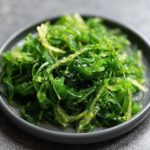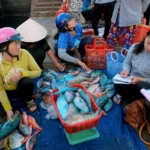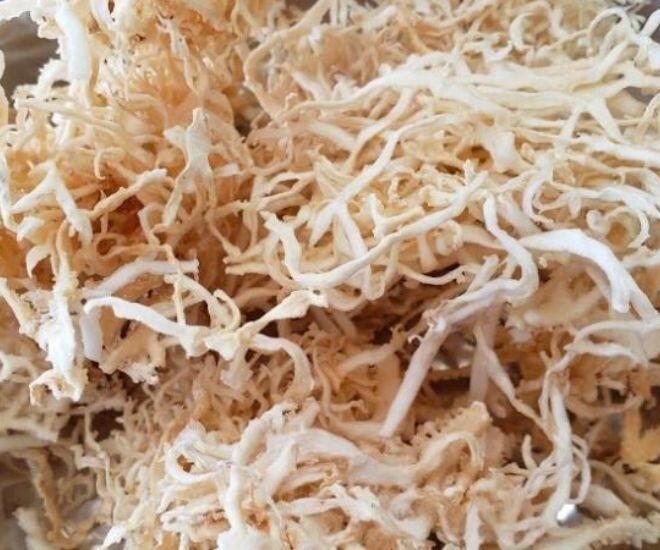
The name “sea vegetable” is no coincidence. It originates from the very place where this seaweed thrives and grows – on the rocky shores of Phu Quy Island. Locals believe that by clinging to the rocks and absorbing the essence of the ocean, this seaweed possesses a cooling quality and exceptional nutritional value. They consider it not just a refreshing delicacy but also a precious specialty, akin to a “gift from heaven” due to its health benefits and positive impact on the local economy.
In terms of appearance, sea vegetable or rong câu in Vietnamese, is a type of seaweed that grows in large patches on the island’s rocks. Its slender stems resemble threads and bear a distinctive brownish-purple hue. While various types of seaweed are found along Vietnam’s coastline, Phu Quy’s sea vegetable is unique in its robust growth and prevalence in specific marine areas like Phu Quy and Phu Quoc, making it a distinctive and valuable product.
The Arduous Harvesting Journey of the “Rong Câu” Gatherers
Obtaining fresh and delicious sea vegetables is no easy task for the people of Phu Quy, especially the women closely tied to the sea. Their journey is filled with challenges and depends heavily on the tides. Harvesting can only commence when the tide recedes, exposing the rocky coral reefs where the seaweed clings tightly.
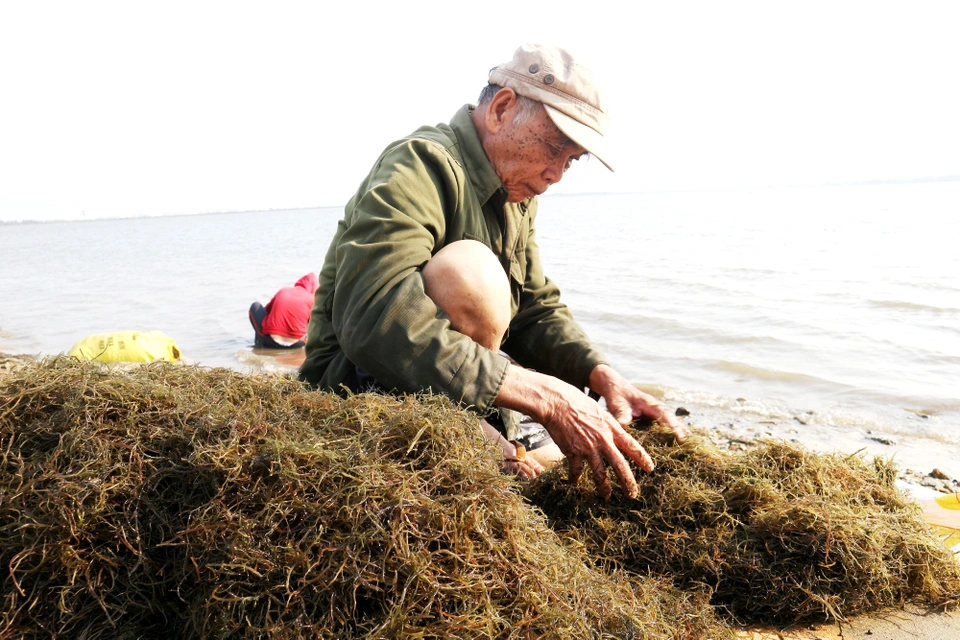
This occupation demands dexterity, caution, and extensive experience. Equipped with simple tools such as a spoon, a small knife, or even a broken shell, the gatherers carefully detach the seaweed strands from the sharp rocks. Their meticulous movements are crucial, as navigating the slippery and jagged coral surface is hazardous. A slight misstep can lead to falls, injuries, or cuts from the rocks. The baskets they carry on their shoulders not only hold their harvest but also symbolize their perseverance, diligence, and deep connection to the sea. They intimately know every wave, rock, and coral reef, and they can pinpoint the exact locations where the rong câu flourishes.
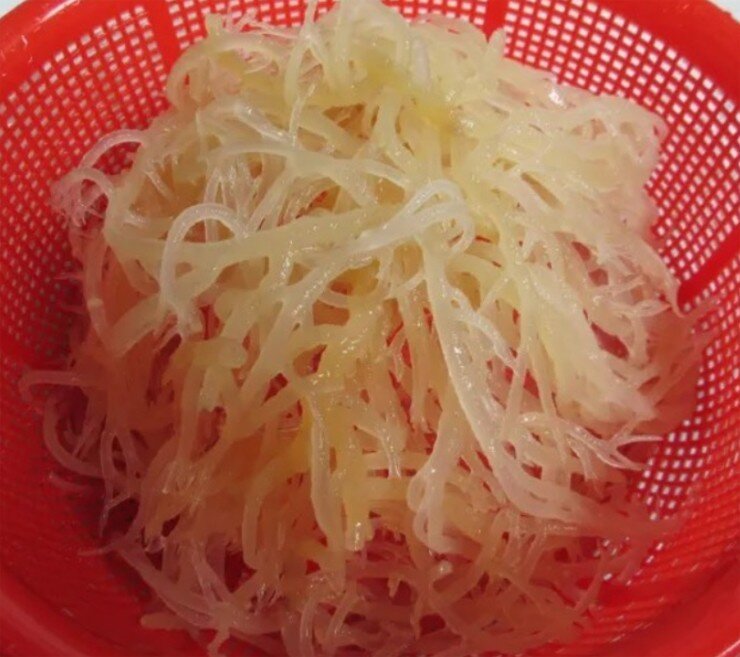
Once harvested from the sea, the Phu Quy seaweed still contains sand, shells, and other impurities. A meticulous and patient cleaning process is required to make it edible. The seaweed is picked over to remove debris and then rinsed repeatedly in freshwater until perfectly clean. It is then spread out thinly to sun-dry, allowing the sun and sea breeze to work their magic. This natural drying process not only preserves the seaweed’s nutritional value but also enhances its natural flavor and enables long-term storage.
A Culinary Delight: Delicious Dishes Created from the “Gift of Heaven”
The creative locals of Phu Quy have crafted a variety of delectable and nutritious dishes from this “gift of heaven,” enriching the island’s cuisine:
Sea Vegetable Porridge: One of the most popular dishes, offering a refreshing and cooling sensation. After being prepared and cleaned, the seaweed is boiled for about 15 minutes. Fresh ginger is added and cooked for another 5 minutes, resulting in a nourishing porridge. It can be enjoyed hot or with ice, blending the chewy texture of the seaweed with the sweetness and spiciness of ginger.
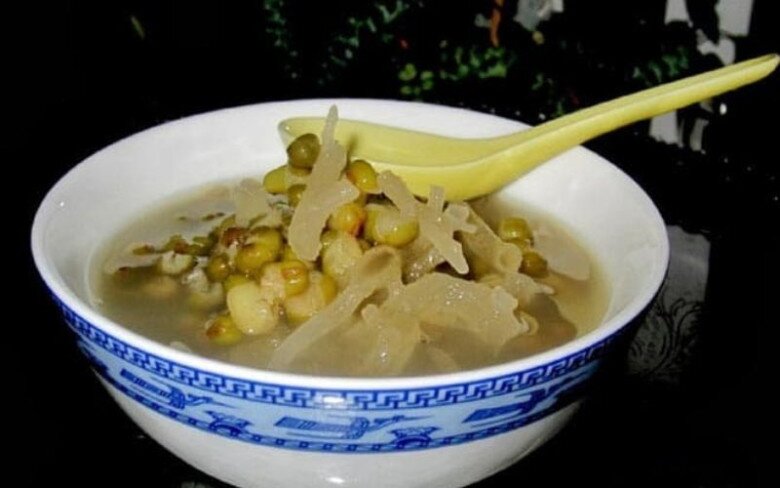
Sea Vegetable Soup: An excellent choice for a hearty family meal. This soup combines seaweed with minced pork, mung beans, coriander, and scallions. The meat is stir-fried until browned, then boiled with the beans and seaweed, creating a flavorful and nourishing soup.
Sea Vegetable Candy: For those with a sweet tooth and a love for chewy textures, this candy is a must-try. Its preparation is intricate and patient. The seaweed is boiled, sugar is added, and the mixture is constantly stirred. It is then poured into trays to set. The candy undergoes a lengthy drying process, after which it is cut into bite-sized pieces, resulting in a natural, chewy, and fragrant treat.
Sea Vegetable Drink: This refreshing beverage is ideal for hot days. Seaweed is boiled with 2-3 liters of water and a bunch of lemongrass. Sugar, vanilla, or ginger can be added to taste. The seaweed is removed, roughly blended to retain its chewiness, and then boiled again. This drink has a cooling effect, is delicious, and can be stored in the refrigerator for later consumption.
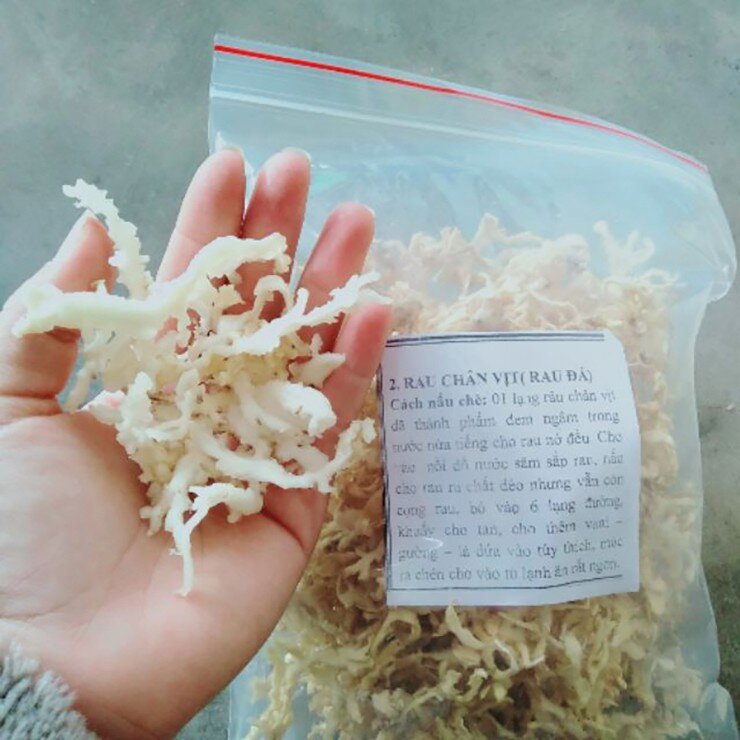
Despite not being their primary occupation, harvesting sea vegetables provides a significant income for the people of Phu Quy. Currently, the price of dried rong câu on the island can reach up to 800,000 VND per kilogram. With its high nutritional value and premium quality, Phu Quy seaweed has gained a reputation in the market, attracting consumers. This not only underscores the worth of a local specialty but also showcases the resilience and ingenuity of the Phu Quy community in harnessing and preserving the ocean’s bounty.
Phu Quy’s sea vegetable, or rong câu, is more than just a delicacy or a local product. It symbolizes the enduring bond between the islanders and nature, and it embodies the traditional values cherished and upheld on this beautiful island.
6 Anti-Aging Foods for Glowing, Youthful Skin
Honey, yogurt, pomegranates, and aloe vera are nature’s treasures for achieving youthful-looking skin. These four powerful ingredients are the secret to a radiant and vibrant complexion. By incorporating them into your diet, you can unlock the key to a glowing and healthy appearance. Discover the ancient secrets to skin rejuvenation with these delicious and nourishing foods.
The Island’s Bustling Seafood Market: Uncovering the Vibrant Heart of Phu Quy Island’s Seafood Scene
The Bãi Phủ market is not just a hub for seafood trade, but also a captivating destination for travelers seeking to immerse themselves in the unique cultural offerings of this remote island. For those fortunate enough to find themselves on Phú Quý Island, a visit to this vibrant early morning market is an unmissable experience.



























